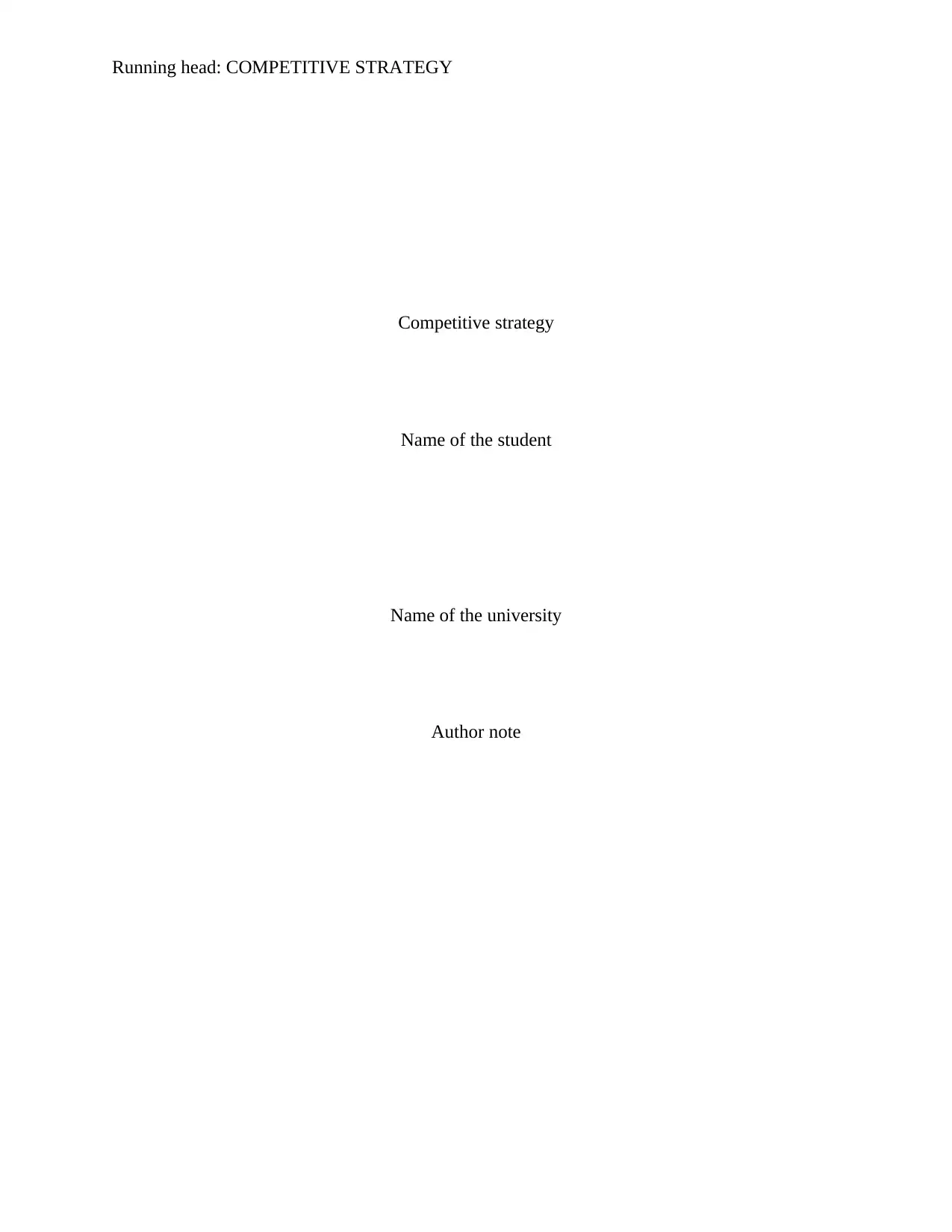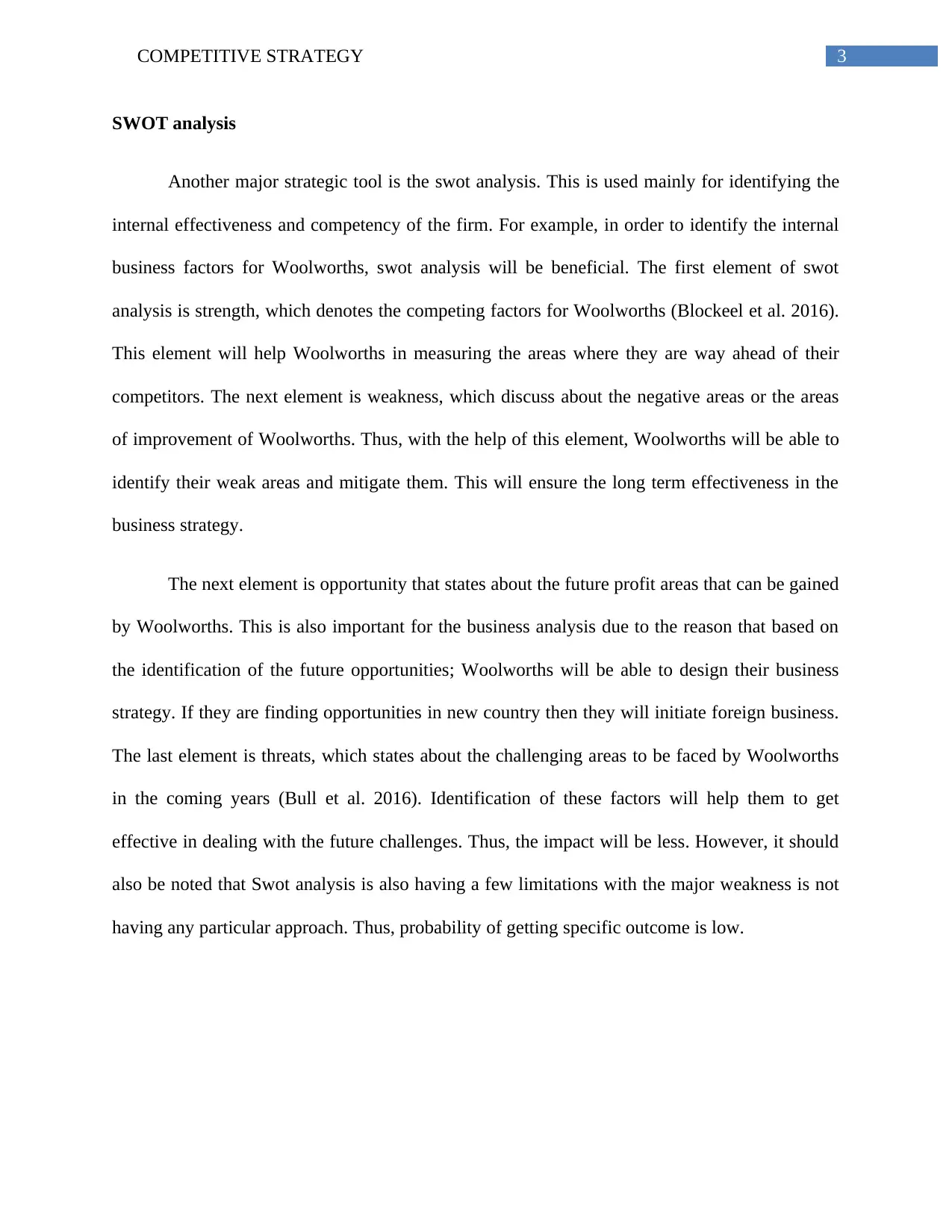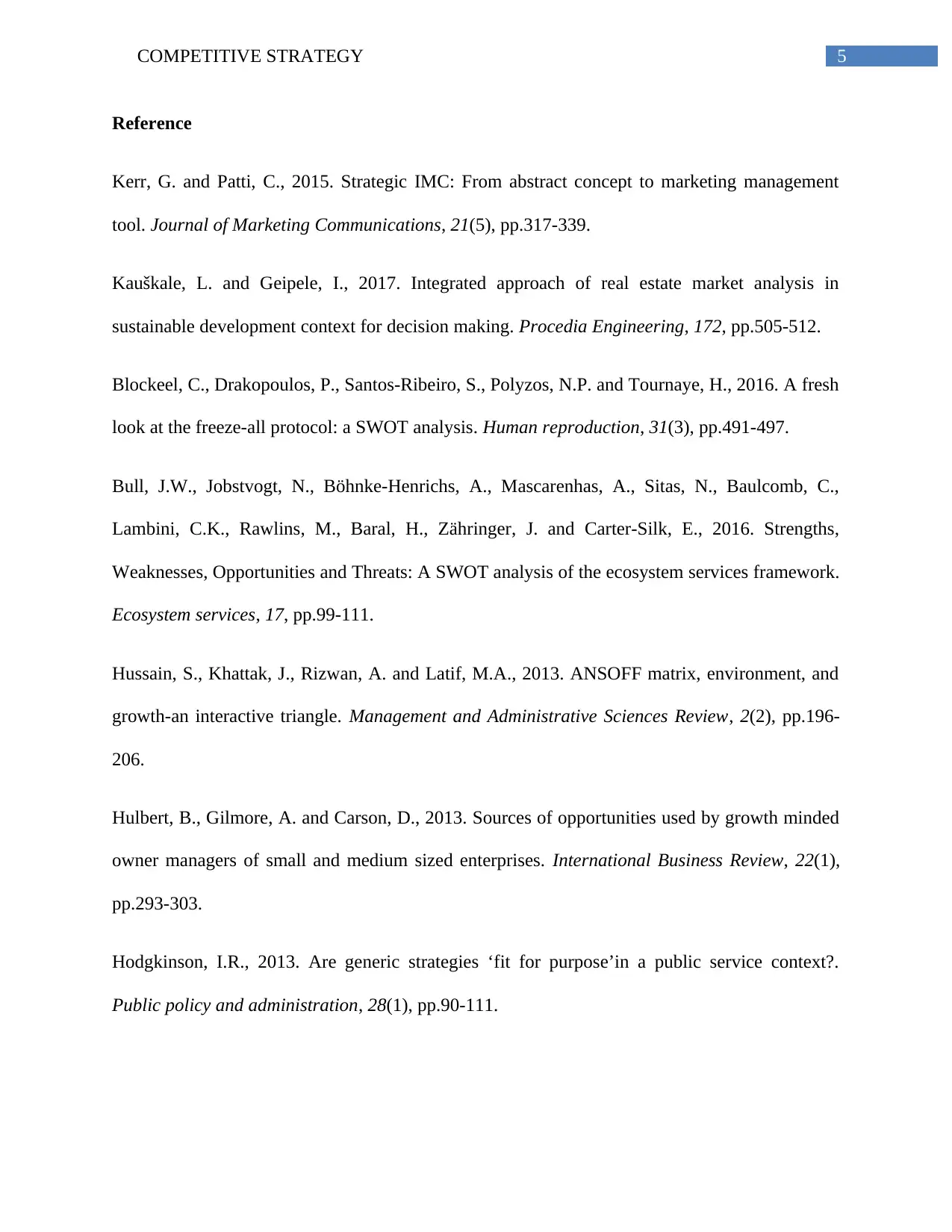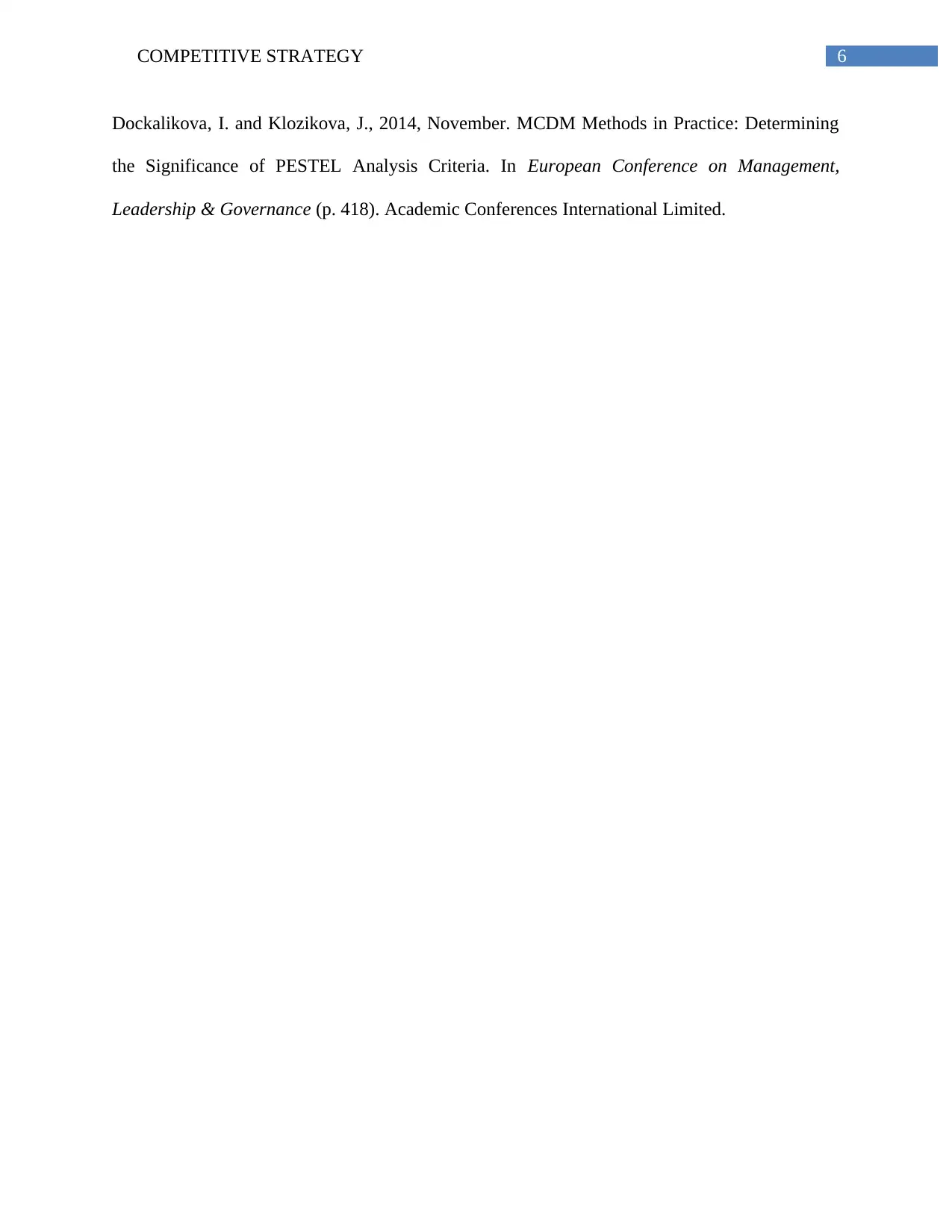University Report: Competitive Strategy Analysis of Business Models
VerifiedAdded on 2022/11/30
|7
|1578
|56
Report
AI Summary
This report provides an in-depth analysis of competitive strategies utilized by businesses. It begins by examining Porter's generic strategies, including cost leadership, differentiation, and market focus, and their application to Qantas. The report then explores the PESTEL analysis, detailing the impact of political, economic, social, technological, legal, and environmental factors on businesses like Coles. Following this, a SWOT analysis is presented, illustrating the strengths, weaknesses, opportunities, and threats for Woolworths. Finally, the Ansoff matrix is discussed, with a focus on product development, market penetration, market development, and diversification strategies for Nura headphones. The report provides real-world examples and highlights the benefits and limitations of each strategic tool.

Running head: COMPETITIVE STRATEGY
Competitive strategy
Name of the student
Name of the university
Author note
Competitive strategy
Name of the student
Name of the university
Author note
Paraphrase This Document
Need a fresh take? Get an instant paraphrase of this document with our AI Paraphraser

1COMPETITIVE STRATEGY
Generic strategies
In the current business state of affairs, it is important for the contemporary entities to
follow different strategic tools for determining their business situations. This is becoming more
important due to the reason that strategic tools can help the business organizations in identifying
the challenges and opportunities and design their strategic intent accordingly (Kerr and Patti
2015). This should also be noted that porter generic strategic model is one of the most popular
frameworks being used in the recent time. It helps in determining the competitive advantages of
the business. Porter’s generic strategies states about the three ways by which competitive
advantages can be gained. Qantas is operating in a highly competitive market and thus they need
to have competitiveness to stay ahead in the competition. The first approach is cost leadership.
With the help of this strategy, Qantas will have to reduce their cost of operation and offer the
flight services in more cost effective price points to the customers. This will help to cater to
larger customer segments (Hodgkinson 2013). The next approach is differentiation. Qantas can
initiate this strategy by offering unique and distinctive services to the customers. This will enable
them to stay different with the competitors. The last approach is market focus. Qantas can focus
on small and niche segment and offer the most premium services according to the specific taste
and preference pattern of focused market. This will cause higher profit margins for Qantas. Thus,
this strategy can help Qantas in having different ways of gaining competitiveness. The major
advantage of this model is that it includes the specific business situations of the organizations
and thus is more effective in meeting the strategic goals.
Generic strategies
In the current business state of affairs, it is important for the contemporary entities to
follow different strategic tools for determining their business situations. This is becoming more
important due to the reason that strategic tools can help the business organizations in identifying
the challenges and opportunities and design their strategic intent accordingly (Kerr and Patti
2015). This should also be noted that porter generic strategic model is one of the most popular
frameworks being used in the recent time. It helps in determining the competitive advantages of
the business. Porter’s generic strategies states about the three ways by which competitive
advantages can be gained. Qantas is operating in a highly competitive market and thus they need
to have competitiveness to stay ahead in the competition. The first approach is cost leadership.
With the help of this strategy, Qantas will have to reduce their cost of operation and offer the
flight services in more cost effective price points to the customers. This will help to cater to
larger customer segments (Hodgkinson 2013). The next approach is differentiation. Qantas can
initiate this strategy by offering unique and distinctive services to the customers. This will enable
them to stay different with the competitors. The last approach is market focus. Qantas can focus
on small and niche segment and offer the most premium services according to the specific taste
and preference pattern of focused market. This will cause higher profit margins for Qantas. Thus,
this strategy can help Qantas in having different ways of gaining competitiveness. The major
advantage of this model is that it includes the specific business situations of the organizations
and thus is more effective in meeting the strategic goals.

2COMPETITIVE STRATEGY
PESTEL analysis
It is one of the most common and popular strategic tools being used by the contemporary
business organizations. Pestel analysis is being used mainly to identify the changes in the
external business environment for the organization. For example, Coles are operating in the
highly competitive and retail industry in Australia. They are having the need for determination of
the changes in the external factor in order to initiate the future strategic plan. The first element of
pestle analysis is political factor, which states the impact of the political regime in the country
(Dockalikova and Klozikova 2014). The impact of the political stability in doing business in
Australia by Coles can be identified. The next element is economical factors that state the
monetary impacts such as the impact of global economic recession on the business of Coles.
Next element is social factors, which states that impact of the changes in preference pattern of
the customers on Coles. Thus, determining this factor will help Coles to have the understanding
about the needs of the customers and offer the products accordingly. The next element is
technological factors that refer to the impact of technological advancement on business. This
helps Coles in identifying the exact needs of technology from where they can be benefited. The
next elements are the legal and environmental factors, which talks about the legal formalities to
be followed and environmental sustainability for the business respectively (Kauskale and
Geipele 2017). Thus, it can be concluded that with the help of the pestel analysis, the overview
of the external business environment can be identified. However, on the other hand, this should
also be noted that pestel analysis is generalized in nature and thus specific factors cannot be
identified from it.
PESTEL analysis
It is one of the most common and popular strategic tools being used by the contemporary
business organizations. Pestel analysis is being used mainly to identify the changes in the
external business environment for the organization. For example, Coles are operating in the
highly competitive and retail industry in Australia. They are having the need for determination of
the changes in the external factor in order to initiate the future strategic plan. The first element of
pestle analysis is political factor, which states the impact of the political regime in the country
(Dockalikova and Klozikova 2014). The impact of the political stability in doing business in
Australia by Coles can be identified. The next element is economical factors that state the
monetary impacts such as the impact of global economic recession on the business of Coles.
Next element is social factors, which states that impact of the changes in preference pattern of
the customers on Coles. Thus, determining this factor will help Coles to have the understanding
about the needs of the customers and offer the products accordingly. The next element is
technological factors that refer to the impact of technological advancement on business. This
helps Coles in identifying the exact needs of technology from where they can be benefited. The
next elements are the legal and environmental factors, which talks about the legal formalities to
be followed and environmental sustainability for the business respectively (Kauskale and
Geipele 2017). Thus, it can be concluded that with the help of the pestel analysis, the overview
of the external business environment can be identified. However, on the other hand, this should
also be noted that pestel analysis is generalized in nature and thus specific factors cannot be
identified from it.
⊘ This is a preview!⊘
Do you want full access?
Subscribe today to unlock all pages.

Trusted by 1+ million students worldwide

3COMPETITIVE STRATEGY
SWOT analysis
Another major strategic tool is the swot analysis. This is used mainly for identifying the
internal effectiveness and competency of the firm. For example, in order to identify the internal
business factors for Woolworths, swot analysis will be beneficial. The first element of swot
analysis is strength, which denotes the competing factors for Woolworths (Blockeel et al. 2016).
This element will help Woolworths in measuring the areas where they are way ahead of their
competitors. The next element is weakness, which discuss about the negative areas or the areas
of improvement of Woolworths. Thus, with the help of this element, Woolworths will be able to
identify their weak areas and mitigate them. This will ensure the long term effectiveness in the
business strategy.
The next element is opportunity that states about the future profit areas that can be gained
by Woolworths. This is also important for the business analysis due to the reason that based on
the identification of the future opportunities; Woolworths will be able to design their business
strategy. If they are finding opportunities in new country then they will initiate foreign business.
The last element is threats, which states about the challenging areas to be faced by Woolworths
in the coming years (Bull et al. 2016). Identification of these factors will help them to get
effective in dealing with the future challenges. Thus, the impact will be less. However, it should
also be noted that Swot analysis is also having a few limitations with the major weakness is not
having any particular approach. Thus, probability of getting specific outcome is low.
SWOT analysis
Another major strategic tool is the swot analysis. This is used mainly for identifying the
internal effectiveness and competency of the firm. For example, in order to identify the internal
business factors for Woolworths, swot analysis will be beneficial. The first element of swot
analysis is strength, which denotes the competing factors for Woolworths (Blockeel et al. 2016).
This element will help Woolworths in measuring the areas where they are way ahead of their
competitors. The next element is weakness, which discuss about the negative areas or the areas
of improvement of Woolworths. Thus, with the help of this element, Woolworths will be able to
identify their weak areas and mitigate them. This will ensure the long term effectiveness in the
business strategy.
The next element is opportunity that states about the future profit areas that can be gained
by Woolworths. This is also important for the business analysis due to the reason that based on
the identification of the future opportunities; Woolworths will be able to design their business
strategy. If they are finding opportunities in new country then they will initiate foreign business.
The last element is threats, which states about the challenging areas to be faced by Woolworths
in the coming years (Bull et al. 2016). Identification of these factors will help them to get
effective in dealing with the future challenges. Thus, the impact will be less. However, it should
also be noted that Swot analysis is also having a few limitations with the major weakness is not
having any particular approach. Thus, probability of getting specific outcome is low.
Paraphrase This Document
Need a fresh take? Get an instant paraphrase of this document with our AI Paraphraser

4COMPETITIVE STRATEGY
Ansoff matrix
Ansoff matrix is being used to identify the potential strategies that can be initiated in
having future opportunities. This model is having major four elements with each of them is
effective in enhancement of the business. For example, Nura headphone is considering different
strategies in further developing their business. With the help of this matrix, they will have a few
options to follow. The first element of this matrix is product development that states about
developing new product for the existing market to cater to new customer segments (Hussain et
al. 2013). Nura headphone can come up with new products for the existing Australian market,
which will help them to have presence in different customer segments. The next element is
market penetration. It states the development of the variants of the existing products in the
existing market. Nura headphone can introduce more cost effective variants of their premium
products to penetrate in the existing market. The next element is market development, which
states about the option of entering in the new markets with existing products. Nura headphone is
not available in different foreign markets thus they can have more target customers with their
existing products (Hulbert, Gilmore and Carson 2013). The last element is diversification, which
states that Nura headphone can diversify their business in different sector in different market.
Hence, there are numbers of option available for Nura headphone. However, there are numbers
of other options available for business enhancements, which are not considered in this model.
Ansoff matrix
Ansoff matrix is being used to identify the potential strategies that can be initiated in
having future opportunities. This model is having major four elements with each of them is
effective in enhancement of the business. For example, Nura headphone is considering different
strategies in further developing their business. With the help of this matrix, they will have a few
options to follow. The first element of this matrix is product development that states about
developing new product for the existing market to cater to new customer segments (Hussain et
al. 2013). Nura headphone can come up with new products for the existing Australian market,
which will help them to have presence in different customer segments. The next element is
market penetration. It states the development of the variants of the existing products in the
existing market. Nura headphone can introduce more cost effective variants of their premium
products to penetrate in the existing market. The next element is market development, which
states about the option of entering in the new markets with existing products. Nura headphone is
not available in different foreign markets thus they can have more target customers with their
existing products (Hulbert, Gilmore and Carson 2013). The last element is diversification, which
states that Nura headphone can diversify their business in different sector in different market.
Hence, there are numbers of option available for Nura headphone. However, there are numbers
of other options available for business enhancements, which are not considered in this model.

5COMPETITIVE STRATEGY
Reference
Kerr, G. and Patti, C., 2015. Strategic IMC: From abstract concept to marketing management
tool. Journal of Marketing Communications, 21(5), pp.317-339.
Kauškale, L. and Geipele, I., 2017. Integrated approach of real estate market analysis in
sustainable development context for decision making. Procedia Engineering, 172, pp.505-512.
Blockeel, C., Drakopoulos, P., Santos-Ribeiro, S., Polyzos, N.P. and Tournaye, H., 2016. A fresh
look at the freeze-all protocol: a SWOT analysis. Human reproduction, 31(3), pp.491-497.
Bull, J.W., Jobstvogt, N., Böhnke-Henrichs, A., Mascarenhas, A., Sitas, N., Baulcomb, C.,
Lambini, C.K., Rawlins, M., Baral, H., Zähringer, J. and Carter-Silk, E., 2016. Strengths,
Weaknesses, Opportunities and Threats: A SWOT analysis of the ecosystem services framework.
Ecosystem services, 17, pp.99-111.
Hussain, S., Khattak, J., Rizwan, A. and Latif, M.A., 2013. ANSOFF matrix, environment, and
growth-an interactive triangle. Management and Administrative Sciences Review, 2(2), pp.196-
206.
Hulbert, B., Gilmore, A. and Carson, D., 2013. Sources of opportunities used by growth minded
owner managers of small and medium sized enterprises. International Business Review, 22(1),
pp.293-303.
Hodgkinson, I.R., 2013. Are generic strategies ‘fit for purpose’in a public service context?.
Public policy and administration, 28(1), pp.90-111.
Reference
Kerr, G. and Patti, C., 2015. Strategic IMC: From abstract concept to marketing management
tool. Journal of Marketing Communications, 21(5), pp.317-339.
Kauškale, L. and Geipele, I., 2017. Integrated approach of real estate market analysis in
sustainable development context for decision making. Procedia Engineering, 172, pp.505-512.
Blockeel, C., Drakopoulos, P., Santos-Ribeiro, S., Polyzos, N.P. and Tournaye, H., 2016. A fresh
look at the freeze-all protocol: a SWOT analysis. Human reproduction, 31(3), pp.491-497.
Bull, J.W., Jobstvogt, N., Böhnke-Henrichs, A., Mascarenhas, A., Sitas, N., Baulcomb, C.,
Lambini, C.K., Rawlins, M., Baral, H., Zähringer, J. and Carter-Silk, E., 2016. Strengths,
Weaknesses, Opportunities and Threats: A SWOT analysis of the ecosystem services framework.
Ecosystem services, 17, pp.99-111.
Hussain, S., Khattak, J., Rizwan, A. and Latif, M.A., 2013. ANSOFF matrix, environment, and
growth-an interactive triangle. Management and Administrative Sciences Review, 2(2), pp.196-
206.
Hulbert, B., Gilmore, A. and Carson, D., 2013. Sources of opportunities used by growth minded
owner managers of small and medium sized enterprises. International Business Review, 22(1),
pp.293-303.
Hodgkinson, I.R., 2013. Are generic strategies ‘fit for purpose’in a public service context?.
Public policy and administration, 28(1), pp.90-111.
⊘ This is a preview!⊘
Do you want full access?
Subscribe today to unlock all pages.

Trusted by 1+ million students worldwide

6COMPETITIVE STRATEGY
Dockalikova, I. and Klozikova, J., 2014, November. MCDM Methods in Practice: Determining
the Significance of PESTEL Analysis Criteria. In European Conference on Management,
Leadership & Governance (p. 418). Academic Conferences International Limited.
Dockalikova, I. and Klozikova, J., 2014, November. MCDM Methods in Practice: Determining
the Significance of PESTEL Analysis Criteria. In European Conference on Management,
Leadership & Governance (p. 418). Academic Conferences International Limited.
1 out of 7
Related Documents
Your All-in-One AI-Powered Toolkit for Academic Success.
+13062052269
info@desklib.com
Available 24*7 on WhatsApp / Email
![[object Object]](/_next/static/media/star-bottom.7253800d.svg)
Unlock your academic potential
Copyright © 2020–2025 A2Z Services. All Rights Reserved. Developed and managed by ZUCOL.



